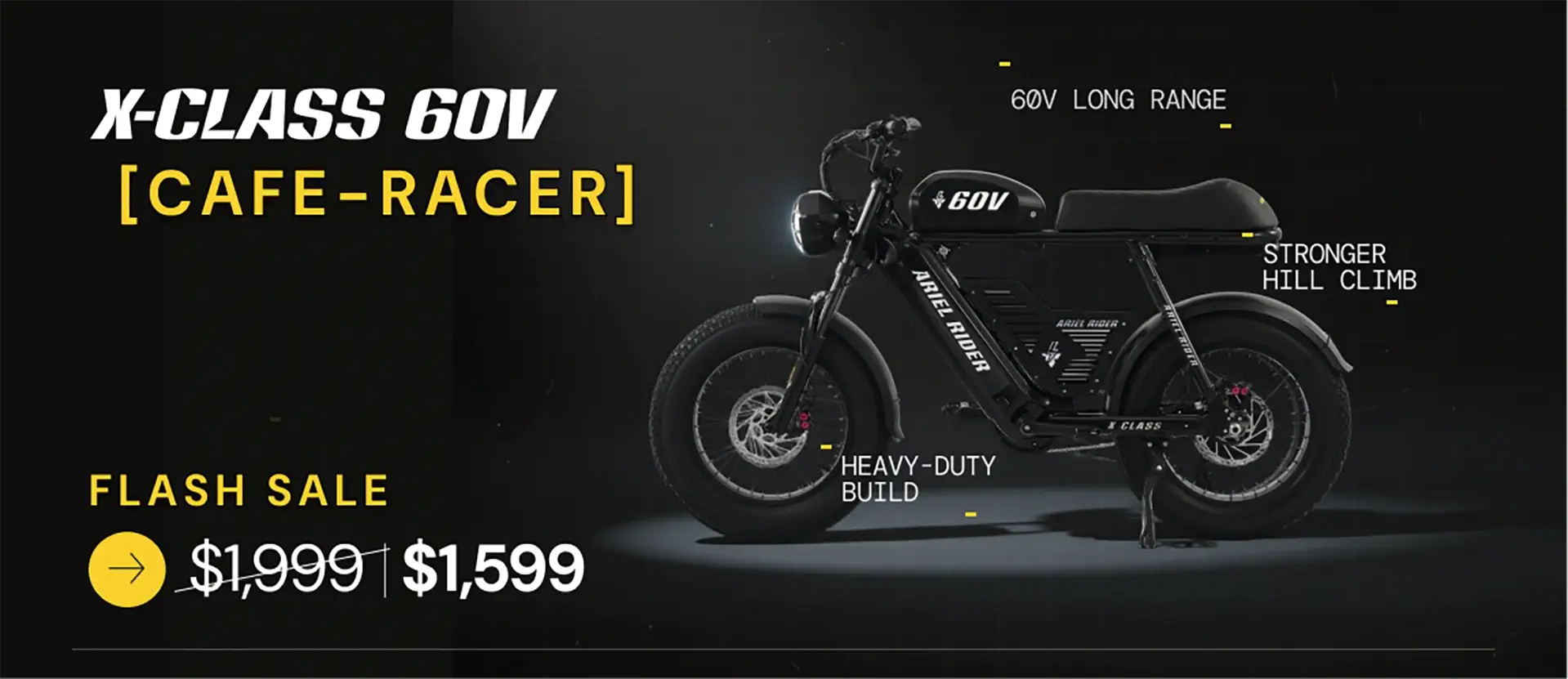Ride smarter with Ariel Rider. This practical e‑bike safety guide covers traffic laws, must‑have gear, maintenance checklists, accident prevention, emergency prep, and why stunts aren’t worth the risk.
Master the Rules of the Road
Understanding and following local traffic laws is the foundation of e‑bike safety.
- Know your local laws: Rules vary by state and city (e‑bike classes, speed caps, where you can ride). Start with PeopleForBikes and confirm with your local DOT.
- Obey signals & signs: Ride as a vehicle. Stop at red lights and stop signs, yield appropriately, and always ride with traffic.
- Use bike lanes when available: They increase predictability and separate you from faster vehicles. If you must take the lane, stay visible and out of the door zone.
Essential Safety Gear
The right kit reduces risk and improves visibility.
- Helmet: Choose a quality, properly fitted helmet. See the Consumer Reports guide to bike helmets.
- High‑visibility clothing & reflectives: Bright colors plus reflective elements help drivers see you at dusk, in rain, and in shade.
- Gloves & pads: Gloves protect palms and improve grip; consider elbow/knee pads for higher‑speed commutes or off‑road rides.
- Lights & audible signal: Run front/rear lights day and night and use a bell or voice when overtaking.
Maintenance for Safe Riding
Small, regular checks prevent big problems and keep your Ariel Rider e‑bike performing well.
- Pre‑ride inspection: Air (tire pressure), Brakes (pad wear, lever feel), Chain/Drivetrain (clean & lubricated), plus bolts and lights. See Bicycle Network’s maintenance tips.
- Battery care: Follow the manufacturer’s charging/storage guidance. Avoid extreme heat/cold and don’t leave the battery fully depleted.
- Keep it clean: Wipe grit—especially around brakes, chain, and connectors; dry the bike after wet rides to deter corrosion.
Riding Etiquette & Best Practices
- Stay alert: Scan ahead for 12–15 seconds. Watch for doors, driveways, intersections, and turning vehicles.
- Signal clearly: Use hand signals for turns/stops and make eye contact when possible.
- Ride defensively: Assume you’re not seen. Keep safe following distances, avoid blind spots, and moderate speed on shared paths.
Emergency Readiness
- Carry a mini first‑aid kit: The American Red Cross lists essentials.
- Know basic repairs: Practice fixing a flat, re‑seating a chain, and tightening bolts before you need to do it roadside. REI Co‑op tutorials are helpful.
- Have ICE info: Store emergency contacts and any medical notes on your phone lock screen or an ID tag.
E‑Bike Accidents: Causes & Prevention
E‑bikes can travel faster and mix with traffic more than traditional bikes, which changes risk. Common contributors include:
- Excess speed for conditions: Higher speed shortens reaction time and lengthens stopping distance.
- Low visibility: Poor lighting and dark clothing reduce conspicuity.
- Traffic violations: Rolling stops, riding against traffic, or unpredictable lane changes.
- Mechanical issues: Worn pads, low tire pressure, loose bolts, or misadjusted drivetrains.
Prevention checklist: Wear a helmet, use lights/reflectives, ride predictably in the correct lane direction, and perform routine pre‑ride checks. Urban riders should take extra care at intersections and when overtaking turning vehicles.
The Dangers of Performing Stunts
Stunts—wheelies, burnouts, stoppies, donuts, hand/tail drags, stand‑up wheelies—dramatically raise crash and injury risk and can endanger others.
- Loss of control: Lifting wheels or over‑braking can exceed traction quickly.
- Higher‑severity impacts: The mass and speed of e‑bikes increase crash forces.
- Public safety & legal issues: Reckless riding in shared spaces may lead to citations and liability.
Safer alternative: Build skills in a quiet lot or clinic—focus on braking drills, scanning, and slow‑speed balance instead of showboating.
Quick “Dos & Don’ts”
Download mobile‑friendly version (1080×1350 PNG)
- Do wear a helmet and run lights day and night.
- Do perform a pre‑ride safety check.
- Do ride predictably and signal early.
- Do follow your model’s battery‑care guidance.
- Don’t ignore traffic signals or ride against traffic.
- Don’t draft closely behind vehicles.
- Don’t exceed rack/frame load ratings.
- Don’t perform dangerous stunts.
Pre‑Ride Safety Checklist
Use this quick list before every ride:
- Tires: Inflate to sidewall PSI; inspect for cuts or embedded debris.
- Brakes: Squeeze levers—feel should be firm; check pad thickness and rotor rub.
- Lights: Confirm front/rear lights turn on; carry a backup if you ride in the dark.
- Drivetrain: Shift through gears; chain should be clean and lubricated.
- Bolts: Check stem, handlebar, seatpost, rack, and fenders for tightness.
- Battery: Secure latch and enough charge for the route.
FAQs
Do I need a license or registration for my e‑bike?
Requirements vary by location and by Class 1/2/3 definitions. Start with PeopleForBikes and confirm with your local DOT.
Are e‑bikes allowed on sidewalks or multi‑use paths?
Rules differ by city and trail system. When in doubt, ride in the bike lane, yield to pedestrians, and follow posted signs.
What speed is safest for city riding?
Match speed to conditions. Slow before intersections and when passing; use lights day and night for visibility.
How often should I service my brakes and tires?
Check before every ride; replace pads when thin/noisy and tires when worn or cut. Frequent riders benefit from a pro tune every 3–6 months.
How should I charge and store my e‑bike battery?
Use the supplied charger, avoid extreme temperatures, charge on a stable, non‑flammable surface, and don’t store fully depleted for long periods.
Can I carry a passenger or cargo on my e‑bike?
Only if your frame/rack is rated for it. Follow your Ariel Rider model specifications and never exceed weight limits.
What should I do after a minor crash?
Move to safety, check for injuries, inspect wheels, brakes, and bars for alignment, and ride cautiously home—or get a shop inspection if unsure.
External Resources
Ride with confidence. Explore Ariel Rider e‑bikes and shop helmets & safety gear. For model‑specific maintenance, visit Ariel Rider Support.
Disclaimer: This guide is for general information and is not legal advice. Always follow your local laws and your Ariel Rider owner’s manual.



